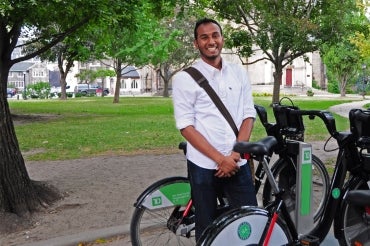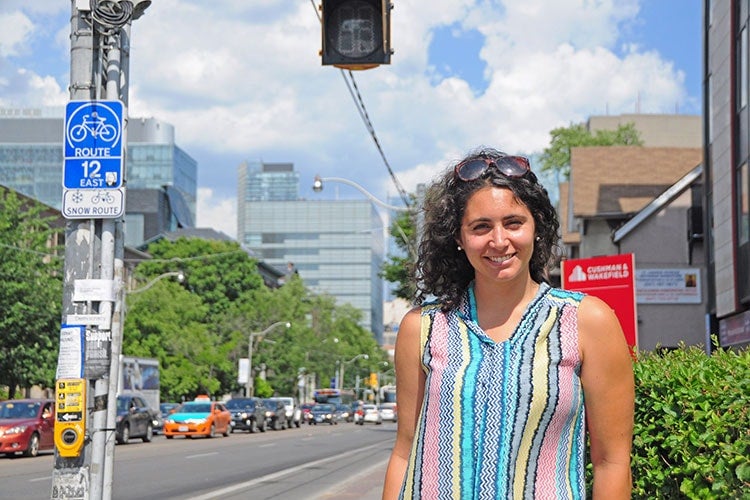How Toronto is getting young people to invest in the city’s future

Published: August 8, 2016
Ten young people, one big challenge: get their generation to play a part in Toronto’s future.
That was the ambitious goal for a research team of 18- to 30-year-olds, chosen by the city’s planning department.
The group spent five intense weeks interviewing, listening to and engaging with youth from diverse backgrounds in neighbourhoods scattered all over the city to uncover the best ways to involve them in the city planning process. After gathering the data, they published a comprehensive report called the Youth Engagement Strategy (YES).
“We have this really diverse city – the most diverse city in the world – but you wouldn’t necessarily know that if you came to one of our planning meetings,” says Daniel Fusca, U of T grad and coordinator of stakeholder engagement and special projects for Toronto’s Office of the Chief Planner – the department that spearheaded the YES project.
“We think it’s really important that we are building a city that reflects the diversity of its people and the diversity of opinions in our city and the broad vision that Torontonians might have and the principals for how this city should be developed.”
YES researcher Jo Flatt was glad to see the city’s willingness to reach younger demographics.
“I was really excited to see the city wanting to actually bring together a bunch of youth to inform planning process and inform their engagement strategy,” says Flatt (pictured below).
Flatt earned her masters of public policy at U of T and now works as a senior project manager with Evergreen CityWorks.
“The future is constantly evolving. The way that we lived in cities 20 years ago isn’t the way we want to live in a city today. You see that in different types of development – the people who are moving downtown,” she says.
“If you don’t reflect younger generations, you’re planning for people who won’t be around to inhabit those buildings in the future.”

Across the board, the researchers found that the biggest concern young people had was that their voices were not being heard.
“There’s a lack of trust that what they would say would have meaningful impact,” says researcher Suhal Ahmed. He’s currently a graduate student at the Dalla Lana School of Public Health at U of T.
One of the most common issues where young Torontonians would like to have a say is transportation, he says.
“Most people enjoy living in Toronto with all the different things that are happening but they just couldn’t reach them and it was really bothering them,” says Ahmed, with bike lanes, the TTC and construction being the hottest topics.
The people that aren’t being represented in planning meetings have unique values and issues that are important to them, but many of them don’t even know that they can get involved in municipal projects, says Fusca.
“People take for granted or don’t realize the city is designed and that they can have a say in the design of their city. People don’t even realize that’s an option for them,” he says.
The report was published one year ago with detailed recommendations on how to bring the plan into practice. This is the most important part of the YES project, says Flatt.
“If we truly want to engage youth, we have to show them that we listen to them when they tell us what they want,” she says.
As the city begins to act on the recommendations, it’s using the core research team as consultants to roll out various projects that will engage young people.
Ahmed, for example, is involved in TO Core, a city-run venture that aims to get people who live in Toronto to help create a plan for re-envisioning the downtown core. He’s spearheading a photo project, asking people to submit their vision of what the city represents to them. Ahmed says it has a lot of enthusiastic participants.
“One of the big things we learned from the Youth Engagement Strategy is that youth will get more involved when [a project is] more creative, more interesting,” he says.
“What’s been really cool is that just the existence of this (YES) document has made staff in the division really aware of the issue of needing to engage youth,” says Fusca. “I get calls all the time from my colleagues about how they can do something better to engage youth in their processes. It’s so clearly on the radar of all my colleagues.”
The interest from within the planning department has made it much easier to launch youth-focused initiatives, says Fusca.
Some of the new projects include: the launch of a podcast called “Invisible City,” hosted by chief planner Jennifer Keesmaat; a larger presence on social media; broadcasting planning meetings online using the Periscope app and adding youth members to various planning committees.
“We’ve done really well,” says Fusca. “We’re probably further ahead than we intended to be at this point.”



